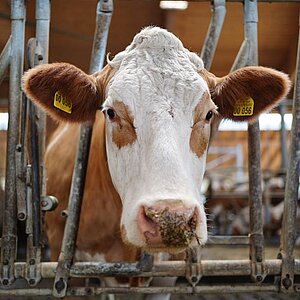Agriculture and AI - technology that thinks for itself
The first thing you look at in the morning is the animals in the barns - but nowadays you also often look at your smartphone. More and more farmers are using digital aids to keep an eye on their animals. For example, an app shows which animal needs special attention today. This is based on data that is collected by sensors around the clock and analyzed by algorithms. What sounds like the future is already part of everyday life on many farms in Bavaria. Digital agriculture is no longer a vision, but practical support. And it is also open to farms that previously had little contact with it.
But despite all the digital sophistication: The responsibility remains with humans. No algorithm can replace a trained eye, no data set can replace the experience of a farmer who knows their animals. Artificial intelligence (AI) supplements what used to be determined by experience and gut feeling alone. Sensors and data analysis help to quickly reveal correlations that would otherwise remain hidden. They help to make precise decisions and use resources sustainably.
The fact that AI systems recognize patterns, learn from data and make recommendations has long been the norm. We encounter AI in navigation systems, voice assistants and smart homes. But in agriculture, it is particularly clear how closely technology and humans need to work together. After all, in the end it is always about living beings or a piece of land.
Silent helper in the stable
Today, cows wear sensors that count steps, measure body temperature and immediately register even the smallest change. In pig and chicken houses, cameras and microphones can record the animals' activity, feeding behavior and vocalizations. AI systems evaluate the data in real time and sound the alarm if something gets out of balance - often before the first symptoms are even visible. The result? Diseases can be treated earlier, animal welfare and performance increase, while feed, water and medication are used more efficiently.
Work processes and workload are also changing. Automated milking systems take over the process around the clock. You are no longer tied to fixed milking times - the robot takes over and offers more freedom. More than 2,000 of these systems are already in use in Bavaria.
AI in crop production - technology in the field
In the fields, too, we can see how far technology has come. Hoeing robots use AI-supported navigation to comb through rows of sugar beet, distinguish between crops and weeds and remove the latter in a targeted manner. Work is currently underway on solutions that enable the targeted application of crop protection products, for example by means of spot spraying. This saves significantly on pesticides and protects the soil and the environment.
In addition, digital forecasting models help to identify stress factors such as drought or nutrient deficiencies at an early stage. This allows farmers to react in good time and control the use of water, fertilizer and pesticides in a targeted manner. This saves resources - and ultimately secures the harvest.
Opportunities yes - but not without challenges
As promising as AI and digital technology are, the path to practical application is not a foregone conclusion. Different systems such as milking robots, feeding systems and herd management software must be able to exchange data. This requires common standards. The infrastructure is just as important: real-time applications only work with stable internet, which is often lacking in rural areas.
Operating the technology also remains an issue. Modern systems are complex and, despite all the automation, the responsibility lies with people. Good training is crucial. After all, only those who have a firm grasp of the technology can really use it to relieve the workload.
Data protection and IT security are also becoming more of a focus. Farms generate large amounts of sensitive data - from yields to animal health. It must be protected and used responsibly. Politicians and associations are working on rules that open up opportunities without relinquishing control over their own data.
Digitization with a sense of proportion
AI is not a panacea, but a tool that needs to be learned and used sensibly. Bavaria is offering support to ensure that the transition is successful: with the BaySL Digital funding program, the state developed comprehensive strategies at an early stage to bring digital technologies into agriculture. In projects such as "Digi-Milch" or the "Farm of the Future" in Ruhstorf, the State Institute for Agriculture (LfL) is testing which technologies will prove their worth in everyday life. Bavarian universities are also developing AI applications for resource-conserving agriculture - tested in practice in fields and stables.
With the Digital Agriculture Competence Network (KNeDL) at Bayern Innovativ, the Bavarian Ministry of Agriculture promotes the exchange between practice, business, research and politics. KNeDL ensures practical technology and knowledge transfer - through practical examples, advice, events and pilot projects. Bayern Innovativ turns ideas into innovations: The company provides impetus, supports projects and brings industries and markets together. This networking also creates new opportunities in agriculture.
>> Artificial intelligence (AI) ...
... refers to the ability of machines to imitate human thought and learning processes. It can collect, process and react to data in order to solve problems and achieve goals. By analyzing past experiences, AI systems adapt their behavior and increasingly act independently.
AI in agriculture
Benefit
- Improve animal welfare: sensors and cameras detect diseases at an early stage, feed and water consumption can be optimized.
- Make everyday work easier: Automatic milking systems take over routine tasks and give more time freedom.
- Conserve resources: Field robots remove weeds in a targeted manner, save pesticides and protect the soil and environment.
- Secure yields: Forecasting models provide early warning of stress factors such as drought or nutrient deficiencies.
- Improve profitability: Investments in smart technology pay off through efficiency and savings.
Challenges
- Technical standards: Systems such as milking robots, feeding systems and management software must be compatible.
- Infrastructure: Real-time data exchange requires stable internet, even in rural areas.
- Complexity: Systems are complex, farmers need training and support.
- Data protection and IT security: Sensitive farm data must be reliably protected and used responsibly.





